And nobody saw it coming.
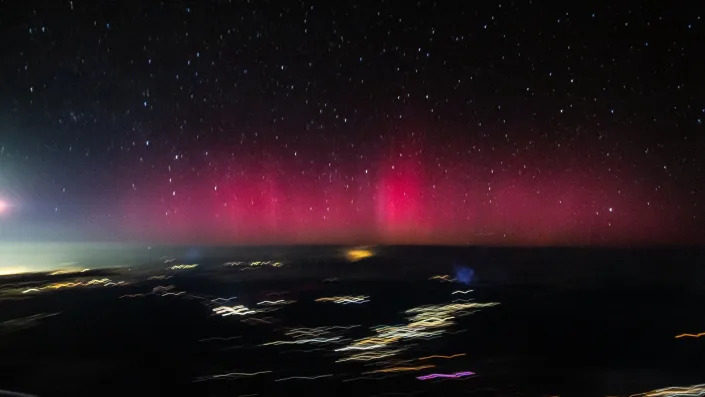
A purple aurora glows on the horizon in a picture taken from an airplane mid flight
Hannah Osborne
Fri, March 24, 2023
The strongest solar storm to hit Earth for six years sparked stunning auroras across the U.S., with intense light displays appearing as far south as Alabama and Northern California. Yet no one saw it coming.
The March 24 solar storm was the result of a "stealth" coronal mass ejection (CME) – or a gargantuan, fast-moving blob of plasma and magnetic field released from the sun – Live Science’s sister site Space.com reports. The CME came from a coronal hole wider than 20 Earths that was spewing out solar winds at speeds over 1.3 million mph (2.1 million km/h).
Tamitha Skov, a U.S. space weather forecaster, told Space.com that no one saw the G4 storm coming because it was "nearly invisible." She said these stealth storms launch far slower than a typical CMEs that erupts, so are more difficult to observe.
The blob of particles smashed into Earth’s atmosphere early on March 24, compressing the planet’s magnetic field and triggering a geomagnetic storm. It was classified as a G4, or "severe" storm on the National Oceanic and Atmospheric Administration’s five-level scale. Impacts of a G4 storm include radio blackouts for several hours and navigation outages.
Storms can also push auroras being pushed to much lower latitudes than usual. Auroras, or Northern Lights, normally only appear at high latitudes near the North and South Poles, because Earth's magnetic field deflects electrons in solar wind toward the poles. But when a solar storm strikes, more charged particles collide with gases in the upper atmosphere, meaning the night light shows can appear closer to the equator.
(The following tweet contains profanity.)
See more
That was the case for last night's stealth storm.
"Forecasters completely missed this one," a post on SpaceWeather.com said. "Auroras spread into the United States as far south as Colorado and New Mexico during a severe (category G4) geomagnetic storm — the most intense in nearly 6 years."
Video and images showing the phenomena were shared by onlookers, including photographer Dakota Snider, who captured images of pink aurora from a flight between Los Angeles and Phoenix.
Snider told Live Science in a message on social media that this was the first time he had seen auroras. Snider closely follows weather and rare events because he is a professional photographer.
"Before we took off I was thinking about how I might get the opportunity to see them from the air, but it would be a pretty far stretch if it was possible. Once we were up at elevation, you could see a faint glow, and I thought it was the lights." Snider said.
"Everyone was asleep on the plane except the flight attendants who were beyond stoked to see such a rare event this far south!"
Vincent Ledvina, an astrophotographer and graduate student at the University of Alaska Fairbanks Geophysical Institute also posted footage of the display. "Witnessed literally the most insane aurora of my life tonight in Fairbanks," he wrote on Twitter. "This was unreal."
Generally, the stronger the geomagnetic storm, the further from the poles auroras can be seen. According to NASA’s Fermilab, in 1859 a solar flare caused auroras as far south as Cuba. The Carrington Event, as it is known, is considered the strongest geomagnetic storm in recorded history.
Editor's Note: This story was updated on Mar. 24 to correct Dakota Snider's pronouns.
Fri, March 24, 2023
The strongest solar storm to hit Earth for six years sparked stunning auroras across the U.S., with intense light displays appearing as far south as Alabama and Northern California. Yet no one saw it coming.
The March 24 solar storm was the result of a "stealth" coronal mass ejection (CME) – or a gargantuan, fast-moving blob of plasma and magnetic field released from the sun – Live Science’s sister site Space.com reports. The CME came from a coronal hole wider than 20 Earths that was spewing out solar winds at speeds over 1.3 million mph (2.1 million km/h).
Tamitha Skov, a U.S. space weather forecaster, told Space.com that no one saw the G4 storm coming because it was "nearly invisible." She said these stealth storms launch far slower than a typical CMEs that erupts, so are more difficult to observe.
The blob of particles smashed into Earth’s atmosphere early on March 24, compressing the planet’s magnetic field and triggering a geomagnetic storm. It was classified as a G4, or "severe" storm on the National Oceanic and Atmospheric Administration’s five-level scale. Impacts of a G4 storm include radio blackouts for several hours and navigation outages.
Storms can also push auroras being pushed to much lower latitudes than usual. Auroras, or Northern Lights, normally only appear at high latitudes near the North and South Poles, because Earth's magnetic field deflects electrons in solar wind toward the poles. But when a solar storm strikes, more charged particles collide with gases in the upper atmosphere, meaning the night light shows can appear closer to the equator.
(The following tweet contains profanity.)
See more
That was the case for last night's stealth storm.
"Forecasters completely missed this one," a post on SpaceWeather.com said. "Auroras spread into the United States as far south as Colorado and New Mexico during a severe (category G4) geomagnetic storm — the most intense in nearly 6 years."
Video and images showing the phenomena were shared by onlookers, including photographer Dakota Snider, who captured images of pink aurora from a flight between Los Angeles and Phoenix.
Snider told Live Science in a message on social media that this was the first time he had seen auroras. Snider closely follows weather and rare events because he is a professional photographer.
"Before we took off I was thinking about how I might get the opportunity to see them from the air, but it would be a pretty far stretch if it was possible. Once we were up at elevation, you could see a faint glow, and I thought it was the lights." Snider said.
"Everyone was asleep on the plane except the flight attendants who were beyond stoked to see such a rare event this far south!"
Vincent Ledvina, an astrophotographer and graduate student at the University of Alaska Fairbanks Geophysical Institute also posted footage of the display. "Witnessed literally the most insane aurora of my life tonight in Fairbanks," he wrote on Twitter. "This was unreal."
Generally, the stronger the geomagnetic storm, the further from the poles auroras can be seen. According to NASA’s Fermilab, in 1859 a solar flare caused auroras as far south as Cuba. The Carrington Event, as it is known, is considered the strongest geomagnetic storm in recorded history.
Editor's Note: This story was updated on Mar. 24 to correct Dakota Snider's pronouns.
Strongest solar storm in nearly 6 years slams into Earth catching forecasters by surprise
Daisy Dobrijevic
Fri, March 24, 2023
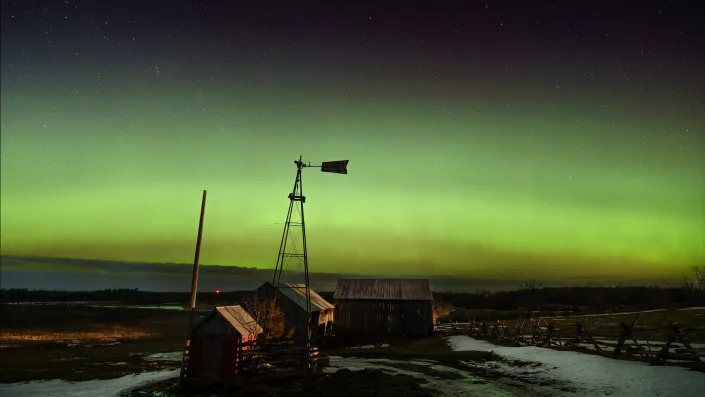
Green band of aurora light in the sky above a rural building.
The most powerful solar storm in nearly six years slammed Earth today (March 24), but strangely, space weather forecasters didn't see it coming.
The geomagnetic storm peaked as a severe G4 on the 5-grade scale used by the U.S. National Oceanic and Atmospheric Administration (NOAA) to assess the severity of space weather events. The storm's unexpected ferocity not only made auroras visible as far south as New Mexico in the U.S., but it also forced spaceflight company Rocket Lab to delay a launch by 90 minutes.
Geomagnetic storms are disturbances to Earth's magnetic field caused by solar material from coronal mass ejections (CME) — large expulsions of plasma and magnetic field from the sun's atmosphere. It turns out that this particular geomagnetic storm was triggered by a "stealth" CME which — as the name suggests — is rather tricky to detect.
Related: Huge solar tornado as tall as 14 Earths hurls plasma cloud into space. Here's the video.
NOAA's National Space Weather Service originally announced a "geomagnetic storm watch" on March 22, to come into effect on 23-25 March with possible moderate G2 storm conditions expected on March 24. So forecasters weren't completely caught off-guard, they however didn't expect a magnitude G4 storm.
It wasn't until 00:41 a.m. EDT ( 0441 GMT) on March 24 that NOAA uprated the warning to a severe G4 storm, which was after a stronger than forecasted G3 storm escalated to a G4 at 12:04 a.m. EDT (0404 GMT).
U.S. space weather forecaster Tamitha Skov explained to Space.com in an email why the space weather community got it so wrong with this latest storm.
"These nearly invisible storms launch much more slowly than eruptive CMEs and are very difficult to observe leaving the sun's surface without specialized training," she said, adding that the stealth CMEs can also be "camouflaged" by other, more dense structures emanating from the sun, which makes them difficult to observe.
"This is why they are the cause of "problem geomagnetic storms" like the G4-level storm we are in now." Skov continued.
You can learn more about these stealthy solar storms in Skov's latest YouTube video where she describes the space weather event in more detail.
NOAA ranks geomagnetic storms on a scale running from G1, which could cause an increase in auroral activity around the poles and minor fluctuations in power supplies, up to G5, which includes extreme cases like the Carrington Event — a colossal solar storm that occurred September 1859, which disrupted telegraph services all over the world and triggered auroras so bright and powerful that they were visible as far south as the Bahamas.
Strong geomagnetic storms can be troublesome for spaceflight as they increase the density of gases in Earth's upper atmosphere, thereby increasing the drag on satellites and other spacecraft. In February 2022 SpaceX lost up to 40 brand-new Starlink satellites when they failed to reach orbit after being launched into a minor geomagnetic storm.
Rocket Lab delayed its launch this morning by approximately 90 minutes while assessing the evolving conditions of the geomagnetic storm, the company announced on Twitter. They successfully launched at 5:14 a.m. EDT (0914 GMT).
Another side effect of powerful geomagnetic storms is the incredible aurora displays they trigger. When energized particles from the sun slam into Earth's atmosphere at speeds of up to 45 million mph (72 million kph), our planet's magnetic field funnels the particles toward the poles. The ensuing supercharging of molecules in Earth's atmosphere triggers the colorful spectacles, which usually remain limited to areas at high latitudes. This time, skywatchers around the world were treated to a dazzling auroral display that reached as far south as Colorado and New Mexico.
We can expect more extreme space weather events like this powerful geomagnetic storm as the sun builds towards a peak in its 11-year solar activity cycle, expected to occur in 2025.
Daisy Dobrijevic
Fri, March 24, 2023

Green band of aurora light in the sky above a rural building.
The most powerful solar storm in nearly six years slammed Earth today (March 24), but strangely, space weather forecasters didn't see it coming.
The geomagnetic storm peaked as a severe G4 on the 5-grade scale used by the U.S. National Oceanic and Atmospheric Administration (NOAA) to assess the severity of space weather events. The storm's unexpected ferocity not only made auroras visible as far south as New Mexico in the U.S., but it also forced spaceflight company Rocket Lab to delay a launch by 90 minutes.
Geomagnetic storms are disturbances to Earth's magnetic field caused by solar material from coronal mass ejections (CME) — large expulsions of plasma and magnetic field from the sun's atmosphere. It turns out that this particular geomagnetic storm was triggered by a "stealth" CME which — as the name suggests — is rather tricky to detect.
Related: Huge solar tornado as tall as 14 Earths hurls plasma cloud into space. Here's the video.
NOAA's National Space Weather Service originally announced a "geomagnetic storm watch" on March 22, to come into effect on 23-25 March with possible moderate G2 storm conditions expected on March 24. So forecasters weren't completely caught off-guard, they however didn't expect a magnitude G4 storm.
It wasn't until 00:41 a.m. EDT ( 0441 GMT) on March 24 that NOAA uprated the warning to a severe G4 storm, which was after a stronger than forecasted G3 storm escalated to a G4 at 12:04 a.m. EDT (0404 GMT).
Graphic illustrating the G4 storm alert and shows high aurora activity in the northern polar regions illustrated by a bright red band across the globe.NOAA's National Space Weather Service declared a G4 solar storm alert on March 24.(Image credit: NOAA Space Weather Prediction Center)
U.S. space weather forecaster Tamitha Skov explained to Space.com in an email why the space weather community got it so wrong with this latest storm.
"These nearly invisible storms launch much more slowly than eruptive CMEs and are very difficult to observe leaving the sun's surface without specialized training," she said, adding that the stealth CMEs can also be "camouflaged" by other, more dense structures emanating from the sun, which makes them difficult to observe.
"This is why they are the cause of "problem geomagnetic storms" like the G4-level storm we are in now." Skov continued.
You can learn more about these stealthy solar storms in Skov's latest YouTube video where she describes the space weather event in more detail.
NOAA ranks geomagnetic storms on a scale running from G1, which could cause an increase in auroral activity around the poles and minor fluctuations in power supplies, up to G5, which includes extreme cases like the Carrington Event — a colossal solar storm that occurred September 1859, which disrupted telegraph services all over the world and triggered auroras so bright and powerful that they were visible as far south as the Bahamas.
Strong geomagnetic storms can be troublesome for spaceflight as they increase the density of gases in Earth's upper atmosphere, thereby increasing the drag on satellites and other spacecraft. In February 2022 SpaceX lost up to 40 brand-new Starlink satellites when they failed to reach orbit after being launched into a minor geomagnetic storm.
Rocket Lab delayed its launch this morning by approximately 90 minutes while assessing the evolving conditions of the geomagnetic storm, the company announced on Twitter. They successfully launched at 5:14 a.m. EDT (0914 GMT).
Another side effect of powerful geomagnetic storms is the incredible aurora displays they trigger. When energized particles from the sun slam into Earth's atmosphere at speeds of up to 45 million mph (72 million kph), our planet's magnetic field funnels the particles toward the poles. The ensuing supercharging of molecules in Earth's atmosphere triggers the colorful spectacles, which usually remain limited to areas at high latitudes. This time, skywatchers around the world were treated to a dazzling auroral display that reached as far south as Colorado and New Mexico.
We can expect more extreme space weather events like this powerful geomagnetic storm as the sun builds towards a peak in its 11-year solar activity cycle, expected to occur in 2025.
Rare show of Northern Lights dazzles North America
Brandon Drenon - BBC News, Washington
Fri, March 24, 2023

Northern Lights appear in the sky over Alaska.
Hues of pink, purple and green streaked the skies in North America overnight in a dazzling display of Northern Lights.
Weather officials said the aurora, which was seen from California to New York, as far south as Arizona and north into Canada, was "fairly unusual".
The event was categorised as a "severe geomagnetic storm" and received the second highest rating in strength, a G4. The strongest would be a G5.
A less severe storm is expected this weekend.
"We got more of an impact than we expected," Bill Murtagh, programme co-ordinator at the National Oceanic and Atmospheric Administration Space Weather and Prediction Center, told the BBC.

The aurora seen on Thursday from Gravenhurst, Ontario, Canada
Mr Murtagh explained that the Northern Lights phenomenon experienced last night was due to "several eruptions on the sun", which released high energy particles that collided with Earth's atmosphere "like a big magnet getting shot out of the sun".
"When these clouds of particles and magnetic fields from the sun hit the Earth's magnetic fields, we see these high energy particles will interact with the Earth's upper atmosphere and that will create the Northern Lights," he said.
An event like this will happen about 50 times every solar cycle, he said, which is 11 years. But this was the most severe geomagnetic storm in almost six years, according to spaceweather.com.
Mr Murtagh said we are currently approaching a point in the solar cycle where more eruptions on the sun will occur, in a period defined as the solar maximum.
Throughout the solar minimum, when activity on the sun is lower, less severe geomagnetic storms more commonly occur, and are typically seen in northern states like New England and along the Canadian border, he said.
But more frequent high level solar storms are on the way.
"The next coming years we are going to see the most solar activity," he said.
Brandon Drenon - BBC News, Washington
Fri, March 24, 2023

Northern Lights appear in the sky over Alaska.
Hues of pink, purple and green streaked the skies in North America overnight in a dazzling display of Northern Lights.
Weather officials said the aurora, which was seen from California to New York, as far south as Arizona and north into Canada, was "fairly unusual".
The event was categorised as a "severe geomagnetic storm" and received the second highest rating in strength, a G4. The strongest would be a G5.
A less severe storm is expected this weekend.
"We got more of an impact than we expected," Bill Murtagh, programme co-ordinator at the National Oceanic and Atmospheric Administration Space Weather and Prediction Center, told the BBC.

The aurora seen on Thursday from Gravenhurst, Ontario, Canada
Mr Murtagh explained that the Northern Lights phenomenon experienced last night was due to "several eruptions on the sun", which released high energy particles that collided with Earth's atmosphere "like a big magnet getting shot out of the sun".
"When these clouds of particles and magnetic fields from the sun hit the Earth's magnetic fields, we see these high energy particles will interact with the Earth's upper atmosphere and that will create the Northern Lights," he said.
An event like this will happen about 50 times every solar cycle, he said, which is 11 years. But this was the most severe geomagnetic storm in almost six years, according to spaceweather.com.
Mr Murtagh said we are currently approaching a point in the solar cycle where more eruptions on the sun will occur, in a period defined as the solar maximum.
Throughout the solar minimum, when activity on the sun is lower, less severe geomagnetic storms more commonly occur, and are typically seen in northern states like New England and along the Canadian border, he said.
But more frequent high level solar storms are on the way.
"The next coming years we are going to see the most solar activity," he said.
A ‘hole’ in the sun’s atmosphere will bring intense northern lights on Friday.
Here’s where you can see them
Ashley Nash
Where will the lights be visible? The aurora borealis forecast predicted a Kp index of 6 for Friday, per Insider, meaning that the lights will be visible somewhere in between the green and yellow lines in the image below:
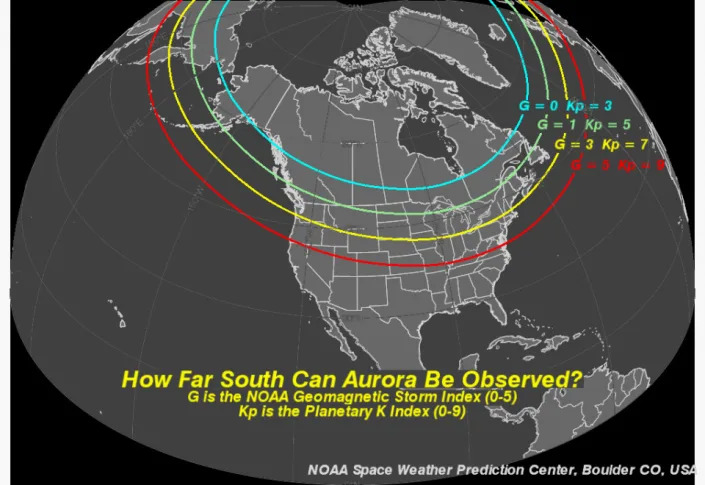
NOAA/Space Weather Prediction Center
The states along the northern border of the U.S. are the most likely to see the lights on Friday.
Tips for viewing the northern lights: The Space Weather Prediction Center states that in order to get a good view of the lights, you need to have a clear view of the northern horizon. Standing on a hill or elevated land is optimal so nothing blocks your view.
It must be dark to view the northern lights, meaning that you’ll need to get away from any city lights. This means that people near large metropolitan areas might have a lower chance of seeing them. Even the full moon or clouds can obstruct the view of the lights.
Northern lights are usually brightest between 10 p.m. and 2 a.m. local time, the SWPC said. The aurora borealis are usually their most intense around the fall and spring equinoxes, which is when geomagnetic storms are more likely to occur.
Ashley Nash
Deseret News
Fri, March 24, 2023
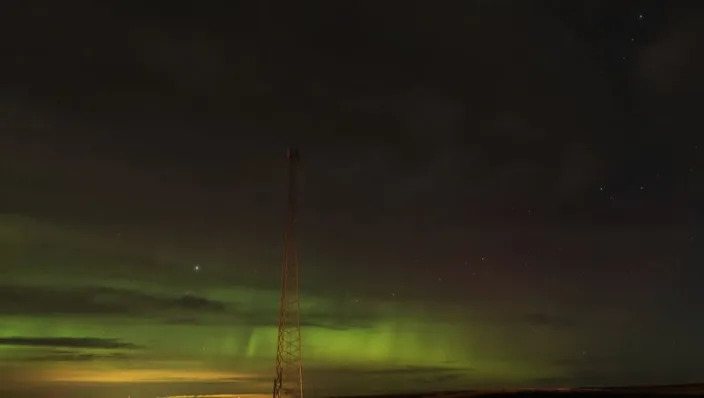
An aurora borealis, also known as the northern lights, is seen in the night sky on Sunday, Feb. 26, 2023, near Washtucna, Wash. The northern lights are predicted to be visible in the U.S. on March 24, 2023, due to an intense solar storm. | Ted S. Warren, Associated Press
Due to the strongest solar storm in five years, several states will be able to witness intense northern lights on Friday night, according to Forbes.
The perfect storm: A combination of cracks in the Earth’s magnetic shield, and a giant coronal hole in the sun’s atmosphere, allowed a “big blast” of charged particles from solar winds cause a G4-class geomagnetic storm, which will result in vibrant northern lights, Forbes stated.
Usually, northern lights are only visible close to the Arctic Circle, but the Space Weather Prediction Center says they could be visible farther south than usual, per Insider.
On Thursday night, the lights were visible in some places as far south as northern California and Nebraska, according to USA Today.
Fri, March 24, 2023

An aurora borealis, also known as the northern lights, is seen in the night sky on Sunday, Feb. 26, 2023, near Washtucna, Wash. The northern lights are predicted to be visible in the U.S. on March 24, 2023, due to an intense solar storm. | Ted S. Warren, Associated Press
Due to the strongest solar storm in five years, several states will be able to witness intense northern lights on Friday night, according to Forbes.
The perfect storm: A combination of cracks in the Earth’s magnetic shield, and a giant coronal hole in the sun’s atmosphere, allowed a “big blast” of charged particles from solar winds cause a G4-class geomagnetic storm, which will result in vibrant northern lights, Forbes stated.
Usually, northern lights are only visible close to the Arctic Circle, but the Space Weather Prediction Center says they could be visible farther south than usual, per Insider.
On Thursday night, the lights were visible in some places as far south as northern California and Nebraska, according to USA Today.
Where will the lights be visible? The aurora borealis forecast predicted a Kp index of 6 for Friday, per Insider, meaning that the lights will be visible somewhere in between the green and yellow lines in the image below:

NOAA/Space Weather Prediction Center
The states along the northern border of the U.S. are the most likely to see the lights on Friday.
Tips for viewing the northern lights: The Space Weather Prediction Center states that in order to get a good view of the lights, you need to have a clear view of the northern horizon. Standing on a hill or elevated land is optimal so nothing blocks your view.
It must be dark to view the northern lights, meaning that you’ll need to get away from any city lights. This means that people near large metropolitan areas might have a lower chance of seeing them. Even the full moon or clouds can obstruct the view of the lights.
Northern lights are usually brightest between 10 p.m. and 2 a.m. local time, the SWPC said. The aurora borealis are usually their most intense around the fall and spring equinoxes, which is when geomagnetic storms are more likely to occur.
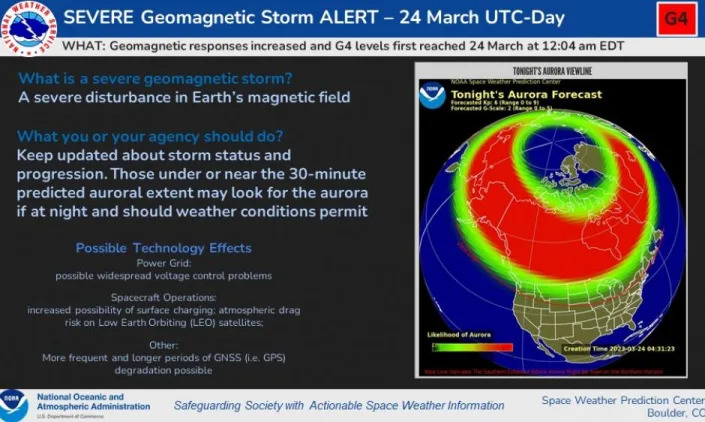
No comments:
Post a Comment